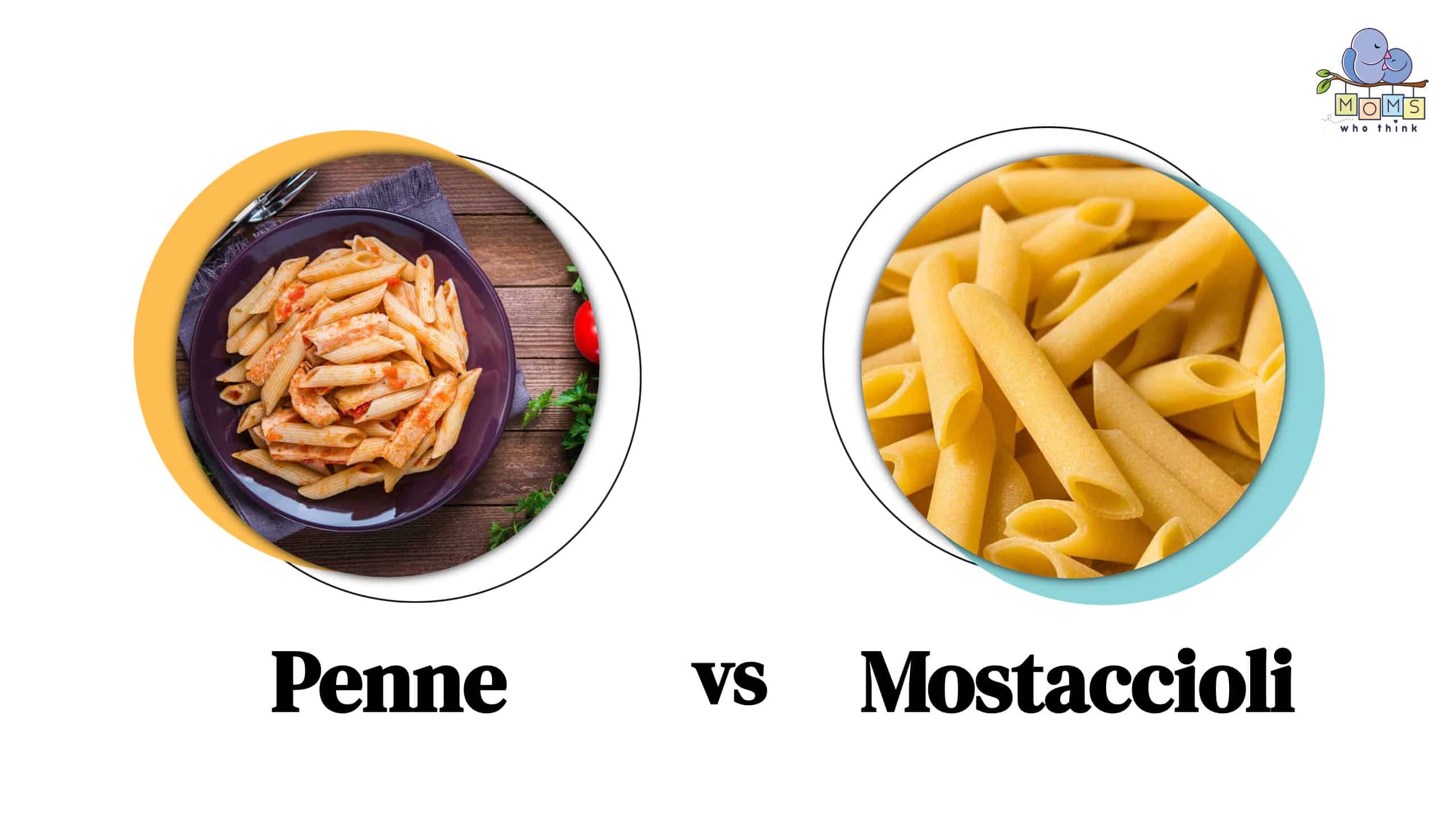From spaghetti to fettuccine, we all have a favorite type of pasta. Penne is one of the most popular types of pasta and it’s easy to find in most American grocery stores. However, if you’ve ever stumbled across mostaccioli noodles, you may have noticed they look a lot like penne.
Mostaccioli (pronounced like muss-tah-chee-OH-lee) is a type of Italian pasta that looks and tastes similar to penne. It’s not surprising when you find out mostaccioli is actually a type of penne! The main difference between mostaccioli and the penne we typically see in the store is their texture. While penne has ridges on the outside, mostaccioli noodles are smooth.
Keep reading to find out the difference between mostaccioli noodles vs. penne, including their taste, texture, and cooking time.
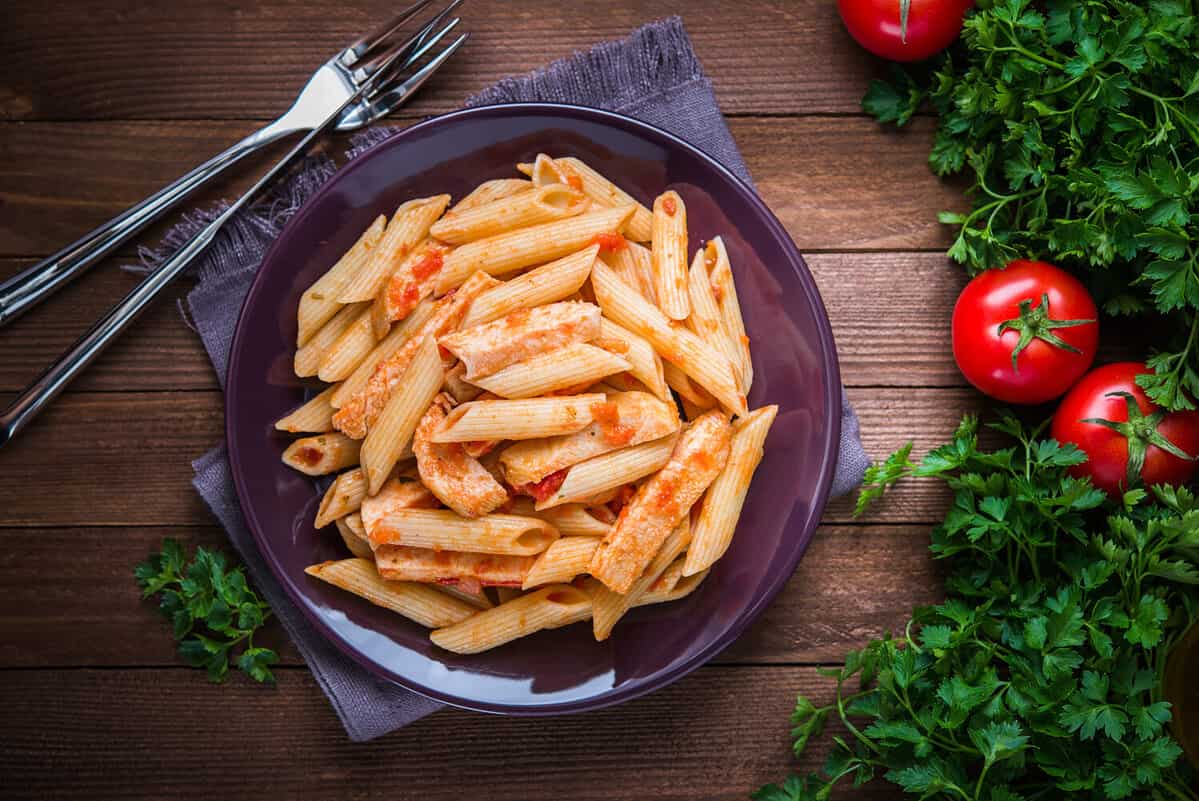
©Elenadesign/Shutterstock.com
Mostaccioli Noodles vs Penne: What Is the Difference?
The most important difference between mostaccioli and penne is that mostaccioli is typically smooth while penne has ridges.
Penne noodles have two different types known as penne rigate and penne lisce. Penne lisce is the type of noodle commonly known as mostaccioli. On the other hand, penne ritgate is the noodle we usually refer to as penne.
The difference of their surface matters in terms of what dishes both pasta are commonly found. Penne is used in a wide variety of dishes as it's a versatile noodle, but mostaccioli is often used in baked pasta dishes with chunky sauces as its smooth surface allows sauces to cling to it well.
The taste of the two types of penne are very similar, but like most types of pasta, the shape and texture are what make all the difference in what kind of entrees they work best with. Flour-based pasta such as penne, ziti, or spaghetti have different shapes and textures because they’re meant to go with different sauces or ingredients.
What Are Penne Noodles?
Penne noodles are tube-shaped pasta cut at an angle. There are actually two different types of penne, but the noodle we refer to as penne in America is one specific kind: penne rigate.
Penne rigate, or penne, can be identified by the ridges on the outside. This is different from penne lisce, or mostaccioli, which have a smooth surface on the outside. Even though they’re made of the same ingredients, the ridges and texture of the pasta does make a difference.
Traditional penne noodles are made of semolina (wheat) and durum wheat flour. Nowadays, there are gluten-free or whole wheat varieties as well.
Penne rigate originated in Northwestern Italy and is traced back to an Italian pasta maker named Giovanni Battista Capurro. He was known for creating a machine that cut pasta dough into a tube shape without crushing or breaking it.
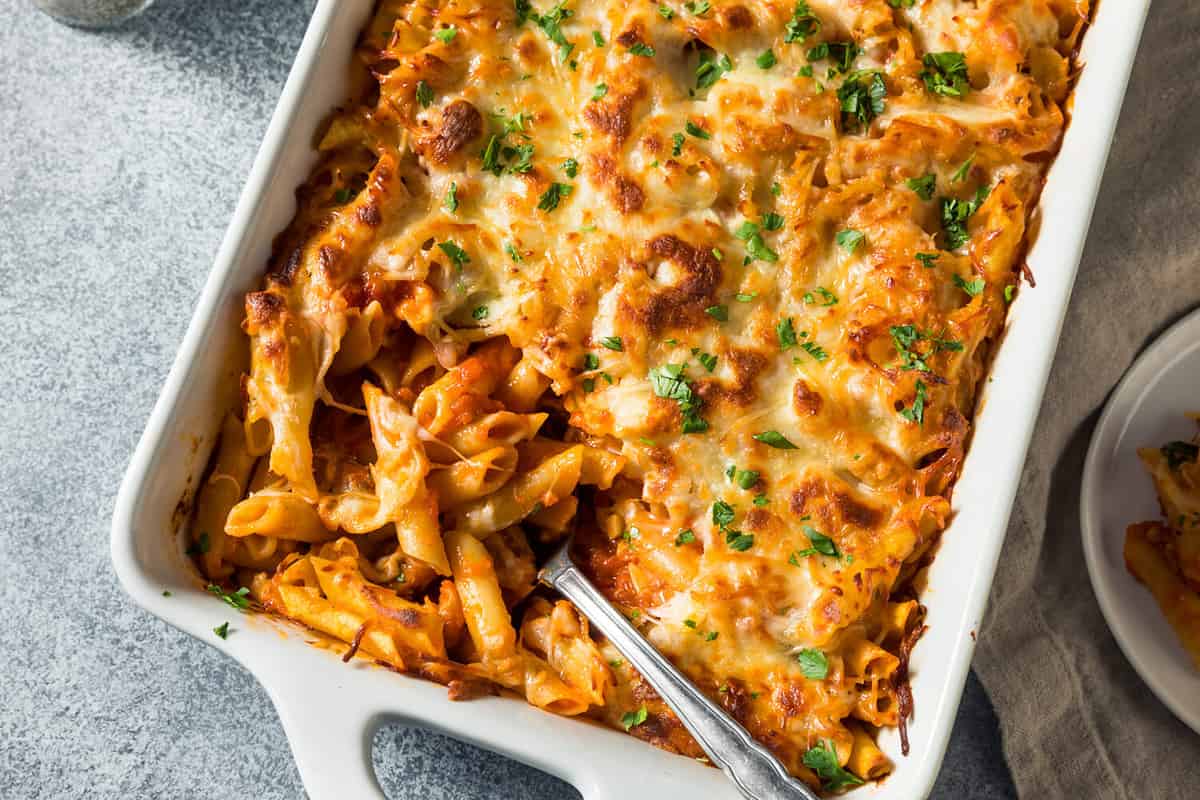
©Brent Hofacker/Shutterstock.com
What Are Mostaccioli Noodles?
Mostaccioli noodles are a type of penne pasta, also known as penne licse. They are similar in the ingredients, taste, and shape, but what sets Mostaccioli noodles apart is their texture. Unlike the ridged exterior or penne rigate, mostaccioli noodles have a smooth exterior.
The name Mostaccioli means “mustaches” in Italian. This type of penne originated in Southern Italy as a variation of penne rigate.
The smooth texture of these noodles makes them perfect to pair with olive oil or lighter sauces. They’re also commonly used in casseroles or other baked dishes.
Can You Substitute Penne for Mostaccioli?
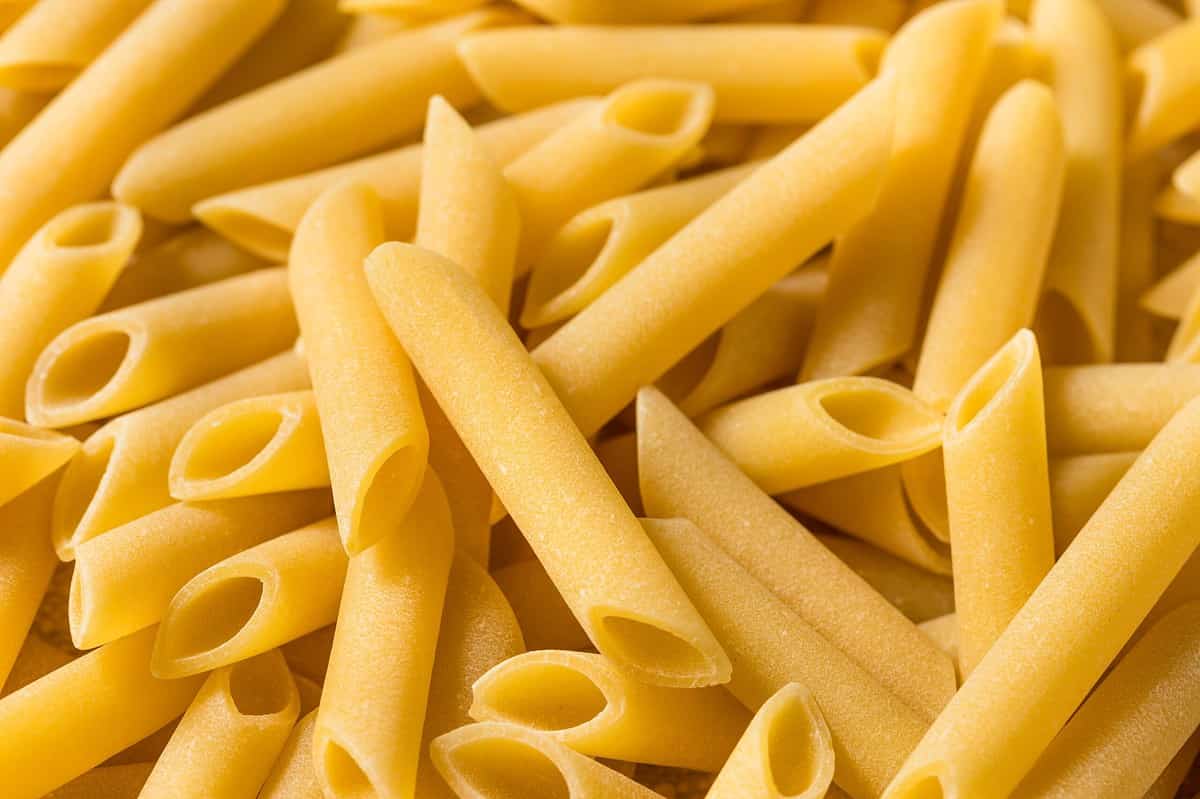
©Brent Hofacker/Shutterstock.com
Penne and mostaccioli are both made with the same type of wheat and even have the same shape. You can substitute penne for mostaccioli or vice versa. The main difference between them is the texture.
Due to the rough exterior of penne, it’s best used with tomato sauce or other thick sauces. The ridges of the noodle are designed to grip the sauce so you end up with more sauce in each bite. On the other hand, mostaccioli has a smooth finish, which makes it a better choice for lighter, thinner sauces.
The preparation for both types of pasta is the same, and the cooking times are also similar, with a minute or two difference. Typically, penne cooks for about 10-13 minutes, whereas mostaccioli cooks for about 14 minutes. If you are substituting one for the other, check your cooking times to ensure you don’t overcook your pasta. When the pasta is finished, it should be firm but not too hard to bite.
Mostaccioli vs. Penne: Nutritional Value Comparison with Calories, Fat, Protein
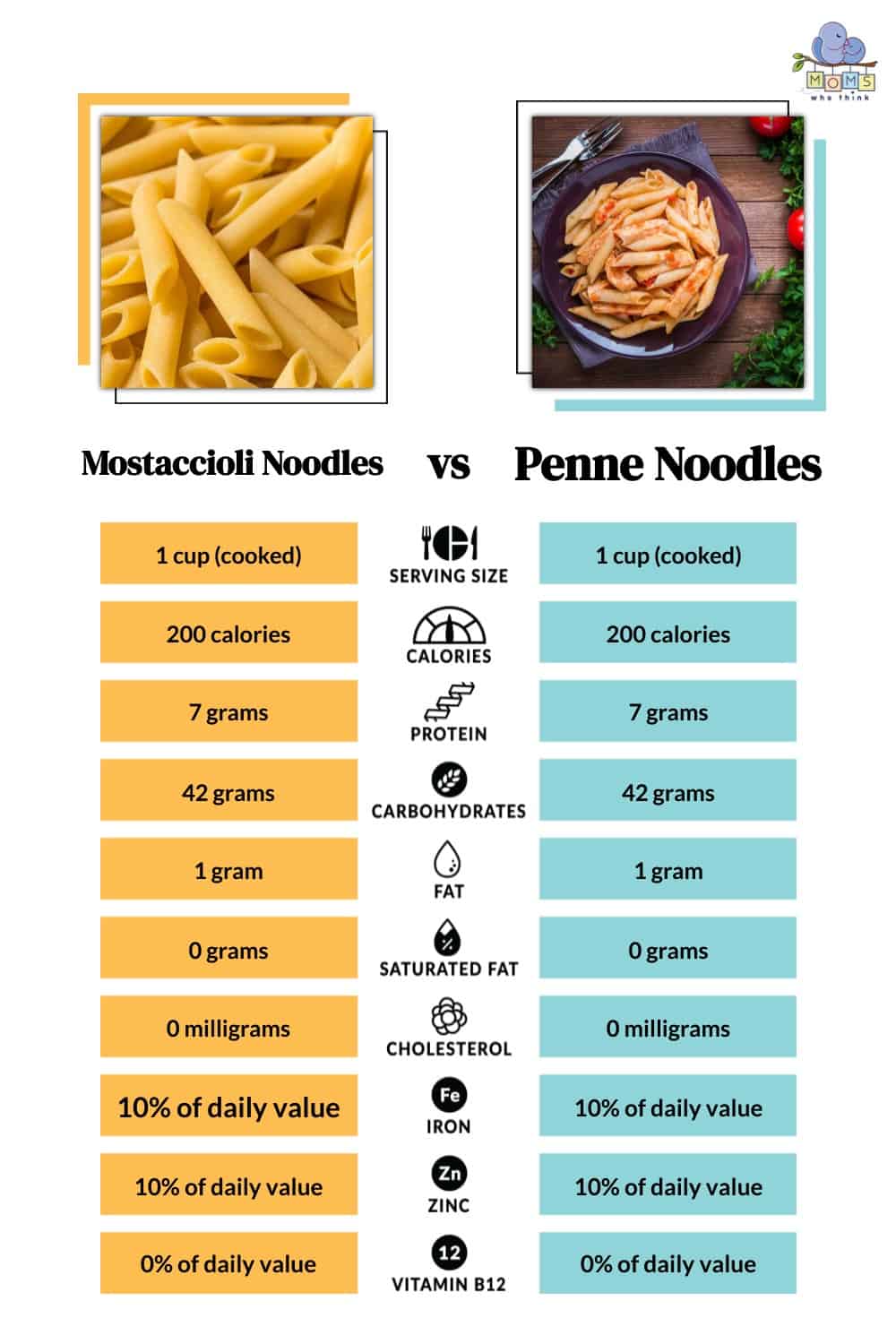
Since mostaccioli and penne are made with the same ingredients and have similar tastes, you might wonder if there’s any difference in their nutritional value. When comparing the nutritional values of the two kinds of pasta from a popular brand like Barilla, there isn’t any difference in the nutritional values. You can find the nutritional values of both types of noodles below:
| Nutritional Values | Mostaccioili (Per 2 oz) | Penne (Per 2 oz) |
| Calories | 200 | 200 |
| Total Fat | 1 g | 1 g |
| Cholesterol | 0 mg | 0 mg |
| Sodium | 0 mg | 0 mg |
| Potassium | 118 mg | 118 mg |
| Carbs | 42 g | 42 g |
| Dietary Fiber | 3 g | 3 g |
| Sugar | 1 g | 1 g |
| Protein | 7 g | 7 g |
What Pasta Is Closest To Mostaccioli?
If you’re looking for a substitute for Mostaccioli, penne is going to be the closest substitution. The main difference between the two is the textures, but you can easily substitute penne for mostaccioli with a few adjustments.
You might choose to substitute penne in your recipe since penne is more commonly found in North American stores. Most store brands or major pasta brands will sell a version of penne, but mostaccioli is not as easy to find.
Is Mostaccioli the Same as Ziti?
There are over 300 types of pasta and it can be difficult to know the difference between all of them. While mostaccioli is cut at an angle, ziti is a tube-shaped pasta with a square-angle cut.
Ziti noodles are also larger than mostaccioli noodles but they do have a smooth texture like mostaccioli. Ziti is most commonly used in baked ziti. Due to the similar shape and texture, mostaccioli noodles could be substituted for ziti in a baked pasta dish.
When Should You Use Mostaccioli Noodles vs. Penne?
Especially in the U.S., it’s common to use most pasta types interchangeably since they’re made of the same ingredients. However, there’s a reason for the different shapes, textures, and sizes of the varying pasta noodles.
Each pasta shape and texture is meant to go with a specific sauce. Textured pasta, such as penne, holds the sauce differently than smooth pasta like mostaccioli. When you use a thicker tomato sauce or meat sauce with penne noodles, you get a delicious bite of sauce with every bite.
Shorter cut pasta like ziti, penne, or mostaccioli is also best for baked pasta dishes, also known as pasta al forno. Most recipes you find for mostaccioli will be baked mostaccioli, which will include different types of cheeses and meat such as ground beef or sausage. You can also make a vegetarian version of the baked pasta.
If you’re not making a baked dish, mostaccioli is best with light olive oil-based sauces or a light tomato sauce. Penne pairs best with thicker meat or vegetable sauces.
Print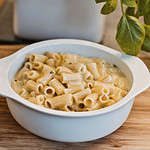
Creamy Pink Penne Pasta
- Yield: 8 servings 1x
Ingredients
- 1 package (16 ounces) penne pasta
- 1 cup thinly sliced onions
- 2 Tablespoons butter
- 2 Tablespoons minced fresh thyme or 2 teaspoons dried thyme
- 2 Tablespoons minced fresh basil or 2 teaspoons dried basil
- 1 teaspoon salt
- 1 1/2 cups half and half cream, divided
- 1/2 cup white wine or reduced sodium chicken broth
- 1 Tablespoon tomato paste
- 2 Tablespoons flour
- 1/2 cup shredded Parmigiano Reggiano cheese, divided
Instructions
- Cook penne according to package directions.
- While pasta is cooking, cook onions in butter in a large nonstick frying pan over medium heat for 8 minutes, or until lightly browned.
- Add the thyme, basil and salt; cook an additional 2 minutes.
- Add 1 cup cream, wine and tomato paste; cook and stir until blended.
- In a small bowl, combine flour and remaining cream, whisking until smooth.
- Gradually stir the flour mixture into the sauce in the frying pan.
- Bring to a boil; cook and stir for 2 minutes or until thickened. Stir in ¼ cup of the cheese.
- Drain penne. Toss with sauce, coating thoroughly. Sprinkle with remaining cheese.
Nutrition
- Serving Size: 1 cup
- Calories: 336
- Sodium: 445mg
- Fat: 10g
- Saturated Fat: 6g
- Carbohydrates: 46g
- Fiber: 2g
- Protein: 12g
- Cholesterol: 36mg
Penne Recipes
- Creamy Pink Penne Pasta
- Penne and Vodka Sauce Recipe
- Penne with Gorgonzola
- Cacciatore-Style Penne
- Penne Pasta Zuppa
Mostaccioli Recipes
- Whole Roast Chicken in the Crock Pot
- Rosemary Tomato and Herbed Chicken with Pasta
- Classic Crock Pot Chicken and Turkey
- Healthy Dinner Recipes
Takeaway
There are so many types of pasta it can be difficult to keep track. Penne is one of the most popular types and it’s easy to find in any grocery store, even in the U.S.
Mostaccioli is actually a type of penne, also known as penne lisce. The penne we know is also called penne rigate, but you will usually see it labeled as just penne. When it comes to mostaccioli noodles vs. penne, the main difference between the two is the texture of their exterior. Both penne and mostaccioli are made with the same ingredients, but penne has a ridged exterior while mostaccioli is smooth. Both types of pasta can be delicious in a variety of dishes.
